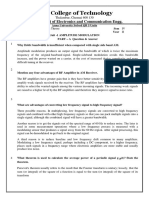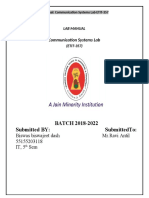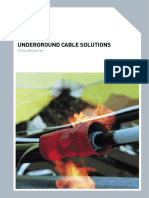Project 3: FM Modulation and Demodulation
Project 3: FM Modulation and Demodulation
Uploaded by
Erman Al HakimCopyright:
Available Formats
Project 3: FM Modulation and Demodulation
Project 3: FM Modulation and Demodulation
Uploaded by
Erman Al HakimOriginal Title
Copyright
Available Formats
Share this document
Did you find this document useful?
Is this content inappropriate?
Copyright:
Available Formats
Project 3: FM Modulation and Demodulation
Project 3: FM Modulation and Demodulation
Uploaded by
Erman Al HakimCopyright:
Available Formats
ECE 460 Introduction to Communications Systems Project #3 Due: Friday, Dec. 7 at 12 p.m. Electronic submissions will NOT be accepted.
Project 3: FM Modulation and Demodulation
Write up the results of this project in the format of a lab report. Clearly state each step, show your models and results, along with the answers to any of the questions. Be sure to include all of the waveform and spectrum plots. Waveform plots should show approximately 3 - 4 cycles of the baseband signal. Spectrum plots should have a resolution of 2 Hz and be expanded so that the component frequencies can be identified. Put your student ID number along with your name on the cover sheet. In this project you will create an FM signal and demodulate it using two different methods. Throughout the project, you will use a baseband signal, x(t), that is based on your student ID number. Assuming that your student ID number is of the form: ABC-DEF-GHI Use a baseband signal:
x (t ) = G cos ( 200 Ht )
If any of the values (G or H) are zero use a 5 instead. The carrier will have a frequency of 20KHz and amplitude of 1. Part A. FM Modulation Use the FM Modulator (Communications Systems Toolbox, Modulation, Analog Passband Modulation library) to generate an FM signal with = 2. Note that the Frequency Deviation parameter in the Simulink block is the frequency deviation constant, kf. Use a Scope and a Spectrum Scope to observe the FM waveform and spectrum. Set the Spectrum Scope to display the one sided spectrum in Watts. Compare the spectral values displayed to the expected values based on the Bessel function. Part B. FM Demodulation Method 1 Use the Simulink FM Demodulator Passband to demodulate this signal. Observe the waveform and the spectrum of the demodulator output to confirm that the correct output is obtained. Part C. FM Demodulation Method 1 with Noise Insert the AWGN Channel block between the modulator and demodulator (Communications Systems Toolbox, Channels library). Set the SNR (Signal to Noise ratio) to 100. Make sure to correctly indicate the input signal power. This block simulates the noise that would occur on an actual communications link. With an SNR of 100dB the output of the demodulator should match your results from part B. Increase the noise by decreasing the SNR. At what SNR do to you begin to see distortion on the demodulated waveform? Double the value of your frequency deviation constant (in both the
modulator and demodulator) and re-run the simulation. How does this affect the distortion that was present? Part D. FM Demodulation Method 2 Return the modulator and demodulator to your original frequency deviation constant. Design and implement a frequency discriminator to demodulate the FM signal. Test your demodulator with the SNR set to 100dB to confirm that it works properly. Note that you may have a DC offset that is fine. Reduce the SNR and observe the output of the Simulink demodulator and your demodulator. Which is most affected by the lower SNR? Compare their performance. Part D. Improving the Simulink Demodulator By observing the output waveform and the spectra of both the Simulink demodulator and your demodulator, can you determine a method for improving the performance of the Simulink demodulator in noise? Modify the system as needed and show that the performance has improved.
You might also like
- Pressure Switch Calibration ProcedureDocument3 pagesPressure Switch Calibration ProcedureRajuNo ratings yet
- Specsheet 3516 1825 kVA PrimeDocument6 pagesSpecsheet 3516 1825 kVA PrimeYusman EkaNo ratings yet
- FM Mod DemodDocument4 pagesFM Mod DemodAllanki Sanyasi RaoNo ratings yet
- AmDocument8 pagesAmLisa TorresNo ratings yet
- FM PDFDocument8 pagesFM PDFAbdullah BhuttaNo ratings yet
- ECE 401L Lab5Document10 pagesECE 401L Lab5mrpatilNo ratings yet
- AM Modulation and DemodulationDocument9 pagesAM Modulation and DemodulationAlemayehu TeshomeNo ratings yet
- COMMUNICATIONS LAB. Experiment #3: Frequency Modulation / DemodulationDocument2 pagesCOMMUNICATIONS LAB. Experiment #3: Frequency Modulation / DemodulationaliNo ratings yet
- EE 306 Matlab HW2Document1 pageEE 306 Matlab HW2aaal09No ratings yet
- Analog & Digital Communications Lab ManualDocument57 pagesAnalog & Digital Communications Lab ManualHarikrishnan Manakara RadhakrishnanNo ratings yet
- FM Demodulation DemoDocument11 pagesFM Demodulation DemoCésar PazNo ratings yet
- EE370 Lab Experiment 04Document4 pagesEE370 Lab Experiment 04Gellie Anne MercadoNo ratings yet
- Analog Communication Lab Final Doc SRN PDFDocument90 pagesAnalog Communication Lab Final Doc SRN PDFChaitanya ReddyNo ratings yet
- The Challenges of Precision Analog Modulation MeasurementDocument13 pagesThe Challenges of Precision Analog Modulation MeasurementriponkumarNo ratings yet
- Analog Communications Lab ManualDocument30 pagesAnalog Communications Lab ManualAnonymous p0bBEKNo ratings yet
- Analog Communications Lab Manual - AsraoDocument128 pagesAnalog Communications Lab Manual - AsraoAllanki Sanyasi RaoNo ratings yet
- Lab 4 Acoustic Direction Finder: Ecen 487 Real-Time Digital Signal Processing LaboratoryDocument6 pagesLab 4 Acoustic Direction Finder: Ecen 487 Real-Time Digital Signal Processing Laboratoryscribd1235207No ratings yet
- Comm Lab Exp3Document2 pagesComm Lab Exp3Ahmed MashhoorNo ratings yet
- Experiment No. 7 Intro To AM Comm.Document12 pagesExperiment No. 7 Intro To AM Comm.John CastroNo ratings yet
- Adc Lab Manual STUDENTDocument59 pagesAdc Lab Manual STUDENTramNo ratings yet
- Lab 5Document5 pagesLab 5Krithika KarriNo ratings yet
- ES442 Lab 6 Frequency Modulation and Demodulation: ObjectiveDocument6 pagesES442 Lab 6 Frequency Modulation and Demodulation: Objectiveحماد حسينNo ratings yet
- ES442 Lab 6 Frequency Modulation and Demodulation: ObjectiveDocument6 pagesES442 Lab 6 Frequency Modulation and Demodulation: ObjectivekidusNo ratings yet
- ANLOG Communication Full Manual...Document54 pagesANLOG Communication Full Manual...ydsraju100% (1)
- Experiment # 4 Amplitude Modulation (AM) (Part 2) : ObjectiveDocument8 pagesExperiment # 4 Amplitude Modulation (AM) (Part 2) : ObjectiveGhaznooq AhmadNo ratings yet
- Experiment 11castroDocument13 pagesExperiment 11castroHarry FabrosNo ratings yet
- Lab ManualDocument15 pagesLab ManualMuhammad SharirNo ratings yet
- Communication Systems Lab - Exp 4Document12 pagesCommunication Systems Lab - Exp 4sujaljindal2026No ratings yet
- Experiment 3 Frequency Modulation ECE 4117 - Telecommunications Laboratory Fall 2012Document5 pagesExperiment 3 Frequency Modulation ECE 4117 - Telecommunications Laboratory Fall 2012Hifdzul Malik ZainalNo ratings yet
- Milwaukee Area Technical College Electronic Technology Electronic Communications Lab Assignment 1 Introduction To The Frequency DomainDocument5 pagesMilwaukee Area Technical College Electronic Technology Electronic Communications Lab Assignment 1 Introduction To The Frequency DomainxendikaNo ratings yet
- Lab ExperimentDocument20 pagesLab ExperimentPrakash JhaNo ratings yet
- The Basics of Radio System DesignDocument7 pagesThe Basics of Radio System DesignMatthew CarterNo ratings yet
- Bab13 TeknikDasarKompresiAudioDocument36 pagesBab13 TeknikDasarKompresiAudioSsemwogerere TomNo ratings yet
- Amplitude Modulation: Name: Branch: Lab Section: ID NoDocument10 pagesAmplitude Modulation: Name: Branch: Lab Section: ID NoSatya GopalNo ratings yet
- Analooge Summer ProjectDocument5 pagesAnalooge Summer ProjectFarah Alaa el Din Hassan KattabNo ratings yet
- Lab3Amplitude ModulationDocument4 pagesLab3Amplitude Modulationmaxxtorr723No ratings yet
- dec 23 pocDocument18 pagesdec 23 pocsagar.chanchlani12345No ratings yet
- Lab 4Document11 pagesLab 4Josephine LegakNo ratings yet
- Frequency ModulationDocument6 pagesFrequency ModulationRavi TeliNo ratings yet
- ADC Lab 3Document14 pagesADC Lab 3200695No ratings yet
- Experiment # 3 Amplitude Modulation and Demodulation: 1 PurposeDocument9 pagesExperiment # 3 Amplitude Modulation and Demodulation: 1 PurposeGeorgeNo ratings yet
- SSBSCDocument4 pagesSSBSCTanjil AdibNo ratings yet
- EEE3086F Prelab2 SimulinkDocument4 pagesEEE3086F Prelab2 SimulinkCarlos ZeballosNo ratings yet
- Agni College of Technology Agni College of Technology Agni College of TechnologyDocument19 pagesAgni College of Technology Agni College of Technology Agni College of TechnologyparantnNo ratings yet
- 20bec1075 Lab MST AdcDocument11 pages20bec1075 Lab MST Adck15No ratings yet
- INTRODUCTION TO COMMUNICATION SYSTEMS Lab3Document8 pagesINTRODUCTION TO COMMUNICATION SYSTEMS Lab3tetraprimigNo ratings yet
- BATCH 2018-2022 Submitted By: SubmittedtoDocument27 pagesBATCH 2018-2022 Submitted By: SubmittedtoshantanuNo ratings yet
- FM Modulation On HardwareDocument13 pagesFM Modulation On HardwareEysha qureshiNo ratings yet
- Ec2307 Cs Lab ManualDocument76 pagesEc2307 Cs Lab ManualrameshdurairajNo ratings yet
- Microwaves101 - Spectrum AnalyzerDocument9 pagesMicrowaves101 - Spectrum AnalyzerThanhha NguyenNo ratings yet
- 1 Am Generation DSB FCDocument9 pages1 Am Generation DSB FCKRUSHNA AHERNo ratings yet
- B.SC Electronics D2 P4 (2020) SolutionsDocument15 pagesB.SC Electronics D2 P4 (2020) SolutionsShubham KeshriNo ratings yet
- Noise Removal: Sinusoidal Signals and FrequencyDocument12 pagesNoise Removal: Sinusoidal Signals and Frequencykatrina99No ratings yet
- Communication LabDocument139 pagesCommunication LabVEERPAL SINGHNo ratings yet
- Electronics and Communication Lab Manual PDFDocument41 pagesElectronics and Communication Lab Manual PDFtester100% (1)
- Communication Theory Question Bank Unit 4Document2 pagesCommunication Theory Question Bank Unit 4muthubeNo ratings yet
- AMANDFMMODUALTIONDocument18 pagesAMANDFMMODUALTIONece bommaNo ratings yet
- Frequency Modulation Analysis: Experiment # 6Document5 pagesFrequency Modulation Analysis: Experiment # 6Ghaznooq Ahmad100% (1)
- Amateur Radio Electronics on Your MobileFrom EverandAmateur Radio Electronics on Your MobileRating: 5 out of 5 stars5/5 (1)
- 33kv GISDocument18 pages33kv GISNagu BandaruNo ratings yet
- Spesifikasi Saadat AriaDocument3 pagesSpesifikasi Saadat AriaJajangNo ratings yet
- CY335 Direct Injection Valve DriverDocument2 pagesCY335 Direct Injection Valve DriverRicardo UrioNo ratings yet
- Tiron de Emergencia Servicio PesadoDocument1 pageTiron de Emergencia Servicio Pesadoenicolas2No ratings yet
- YA587 r005Document28 pagesYA587 r005taraservNo ratings yet
- Eaton DXRT Ups Brochure 15 20kvaDocument4 pagesEaton DXRT Ups Brochure 15 20kvaking mohNo ratings yet
- MTM-HF Advanced Multi ChargerDocument4 pagesMTM-HF Advanced Multi ChargerДмитро СелютінNo ratings yet
- Up Eei Inverter 09 24Document1 pageUp Eei Inverter 09 24Earl IneNo ratings yet
- RE 615 Installationmanual ENsDocument96 pagesRE 615 Installationmanual ENsElmirNo ratings yet
- URI514 Catalog02Document95 pagesURI514 Catalog02ednerNo ratings yet
- uCOS ViewDocument48 pagesuCOS Viewapi-3721578No ratings yet
- Amplitude Modulated Fourier Series: F (T) (O, T) F (T) F (T) NW B, BI NW (O, T) F (T)Document7 pagesAmplitude Modulated Fourier Series: F (T) (O, T) F (T) F (T) NW B, BI NW (O, T) F (T)Ahmad Raees QayyumNo ratings yet
- Ieee-1016 (1987)Document14 pagesIeee-1016 (1987)ballasreedharNo ratings yet
- Wib2dflyer eDocument1 pageWib2dflyer esea13No ratings yet
- 3C5 Tutorial Sheet 6: Dr. David Corrigan 18 March 2011Document5 pages3C5 Tutorial Sheet 6: Dr. David Corrigan 18 March 2011Naresh KadyanNo ratings yet
- Reliance To Baldor - Cross ReferenceDocument4 pagesReliance To Baldor - Cross Referenceumer0905No ratings yet
- Automatic Traffic Camera Control For Vehicles Breaking Traffic RulesDocument44 pagesAutomatic Traffic Camera Control For Vehicles Breaking Traffic RulesNoor Ul Haq ShaikhNo ratings yet
- Life of Devourer IIDocument192 pagesLife of Devourer IIJames SniderNo ratings yet
- O. Gafri, A. Izhar, Y. Livshitz and V. Shribman - Magnetic Pulse AccelerationDocument8 pagesO. Gafri, A. Izhar, Y. Livshitz and V. Shribman - Magnetic Pulse AccelerationCola7890No ratings yet
- Dorrough DAP 310 AM Peak Limiter II ManualDocument6 pagesDorrough DAP 310 AM Peak Limiter II Manualallensteel1580No ratings yet
- Underground Cable Solutions PDFDocument40 pagesUnderground Cable Solutions PDFahdabmkNo ratings yet
- 8096or8097 Microcontroller PDFDocument38 pages8096or8097 Microcontroller PDFStoriesofsuperheroes50% (2)
- System Software, 3e - Leland L.beckDocument259 pagesSystem Software, 3e - Leland L.beckHytec GowthamanNo ratings yet
- 13TR T4DDocument1 page13TR T4Dfox7878No ratings yet
- Verilog HDLDocument74 pagesVerilog HDLgautamsvksNo ratings yet
- YET402PC: Two-Circuit Wireless Smart Receiving ControllerDocument2 pagesYET402PC: Two-Circuit Wireless Smart Receiving ControllerVrhovac RadenkoNo ratings yet
- Delta Compact 2 MDocument4 pagesDelta Compact 2 MEscape ExistNo ratings yet
- Chip-Level FPGA Verification: How To Use A VHDL Test Bench To Perform A System Auto TestDocument11 pagesChip-Level FPGA Verification: How To Use A VHDL Test Bench To Perform A System Auto TestMitesh KhadgiNo ratings yet

























































































